MKT600 Principles of Marketing
VerifiedAdded on 2021/09/11
|14
|2859
|78
AI Summary
Contribute Materials
Your contribution can guide someone’s learning journey. Share your
documents today.

Running head: PRINCIPLES OF MARKETING
Principles of marketing
Name of the student
Name of the university
Author note
Principles of marketing
Name of the student
Name of the university
Author note
Secure Best Marks with AI Grader
Need help grading? Try our AI Grader for instant feedback on your assignments.
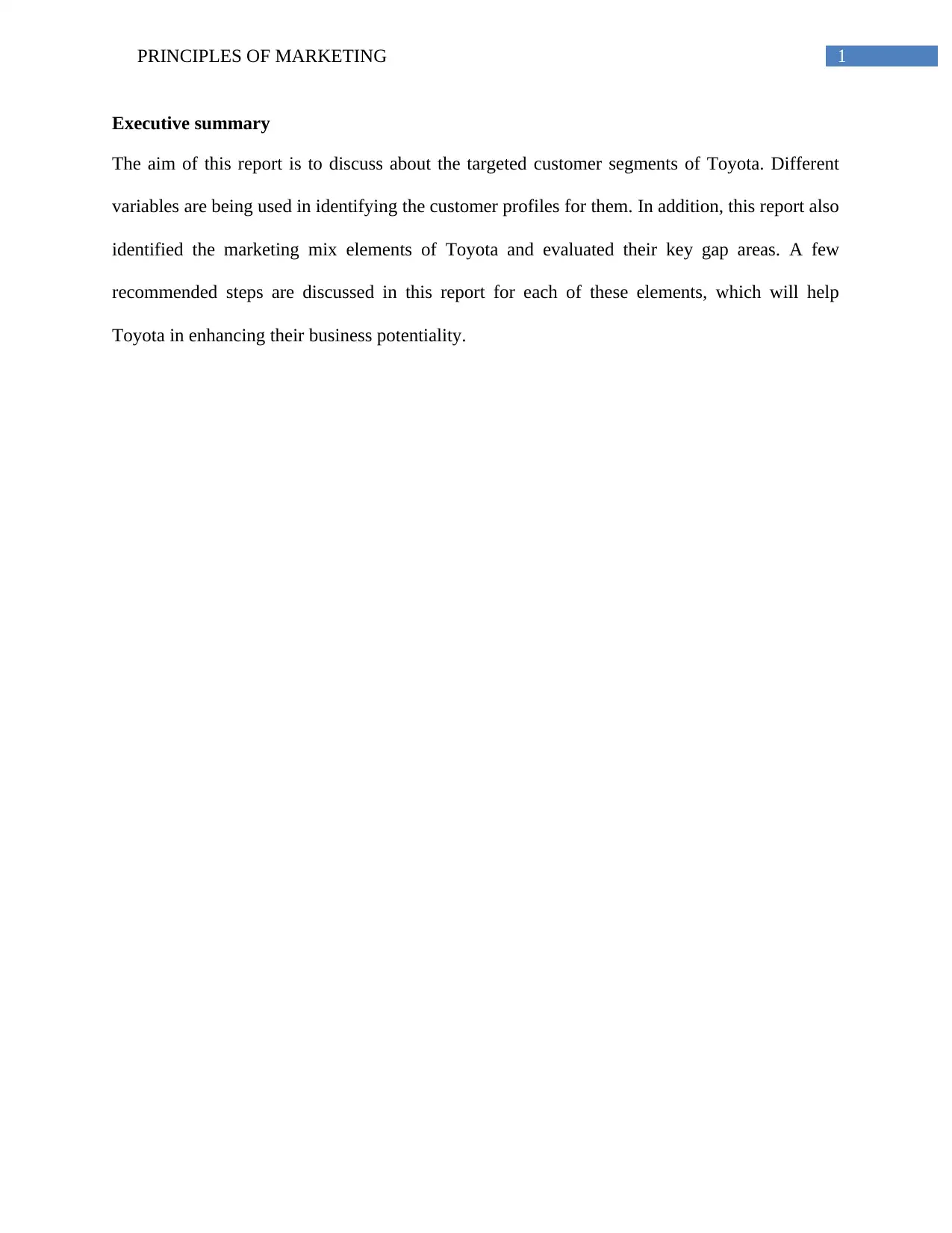
1PRINCIPLES OF MARKETING
Executive summary
The aim of this report is to discuss about the targeted customer segments of Toyota. Different
variables are being used in identifying the customer profiles for them. In addition, this report also
identified the marketing mix elements of Toyota and evaluated their key gap areas. A few
recommended steps are discussed in this report for each of these elements, which will help
Toyota in enhancing their business potentiality.
Executive summary
The aim of this report is to discuss about the targeted customer segments of Toyota. Different
variables are being used in identifying the customer profiles for them. In addition, this report also
identified the marketing mix elements of Toyota and evaluated their key gap areas. A few
recommended steps are discussed in this report for each of these elements, which will help
Toyota in enhancing their business potentiality.
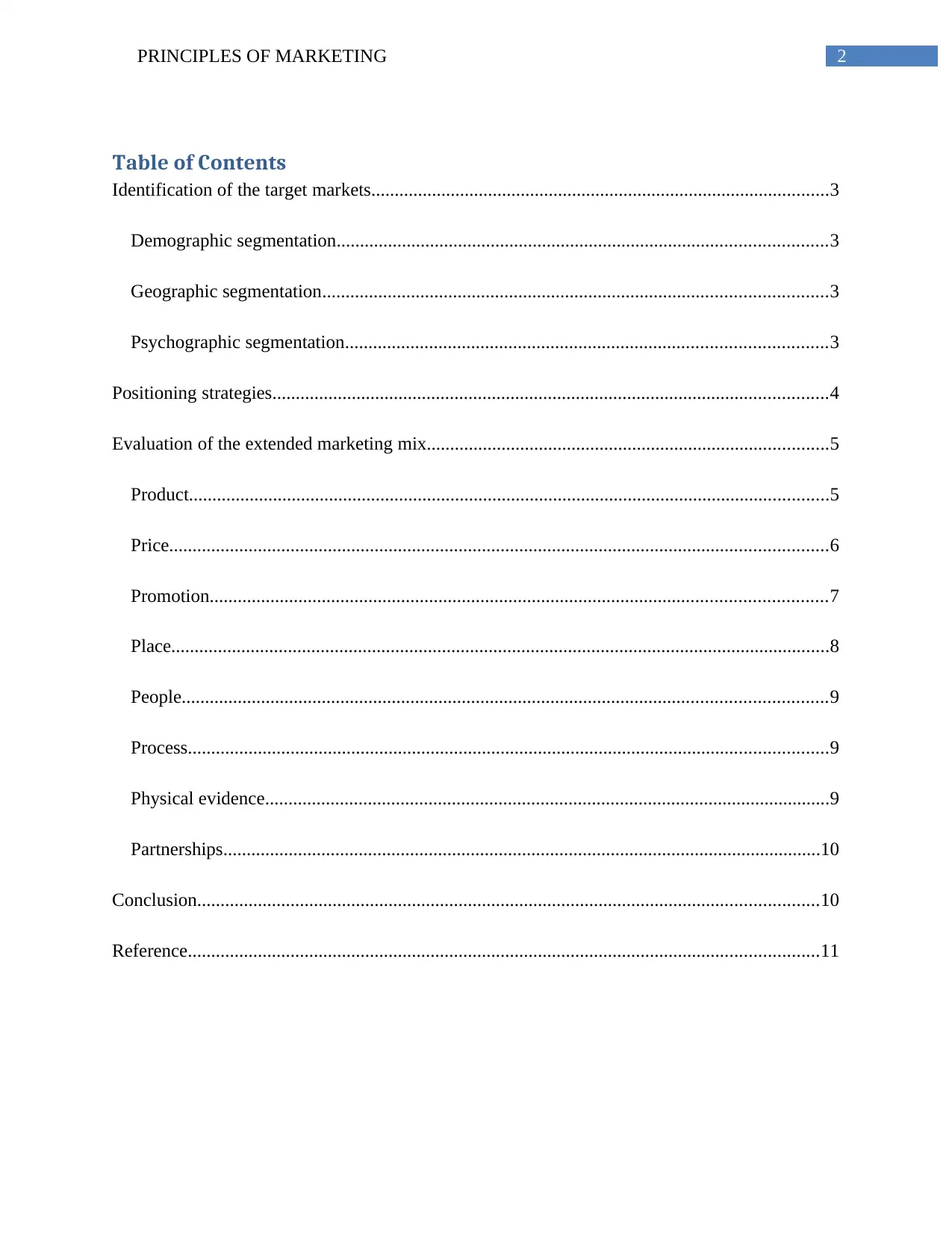
2PRINCIPLES OF MARKETING
Table of Contents
Identification of the target markets..................................................................................................3
Demographic segmentation.........................................................................................................3
Geographic segmentation............................................................................................................3
Psychographic segmentation.......................................................................................................3
Positioning strategies.......................................................................................................................4
Evaluation of the extended marketing mix......................................................................................5
Product.........................................................................................................................................5
Price.............................................................................................................................................6
Promotion....................................................................................................................................7
Place.............................................................................................................................................8
People..........................................................................................................................................9
Process.........................................................................................................................................9
Physical evidence.........................................................................................................................9
Partnerships................................................................................................................................10
Conclusion.....................................................................................................................................10
Reference.......................................................................................................................................11
Table of Contents
Identification of the target markets..................................................................................................3
Demographic segmentation.........................................................................................................3
Geographic segmentation............................................................................................................3
Psychographic segmentation.......................................................................................................3
Positioning strategies.......................................................................................................................4
Evaluation of the extended marketing mix......................................................................................5
Product.........................................................................................................................................5
Price.............................................................................................................................................6
Promotion....................................................................................................................................7
Place.............................................................................................................................................8
People..........................................................................................................................................9
Process.........................................................................................................................................9
Physical evidence.........................................................................................................................9
Partnerships................................................................................................................................10
Conclusion.....................................................................................................................................10
Reference.......................................................................................................................................11
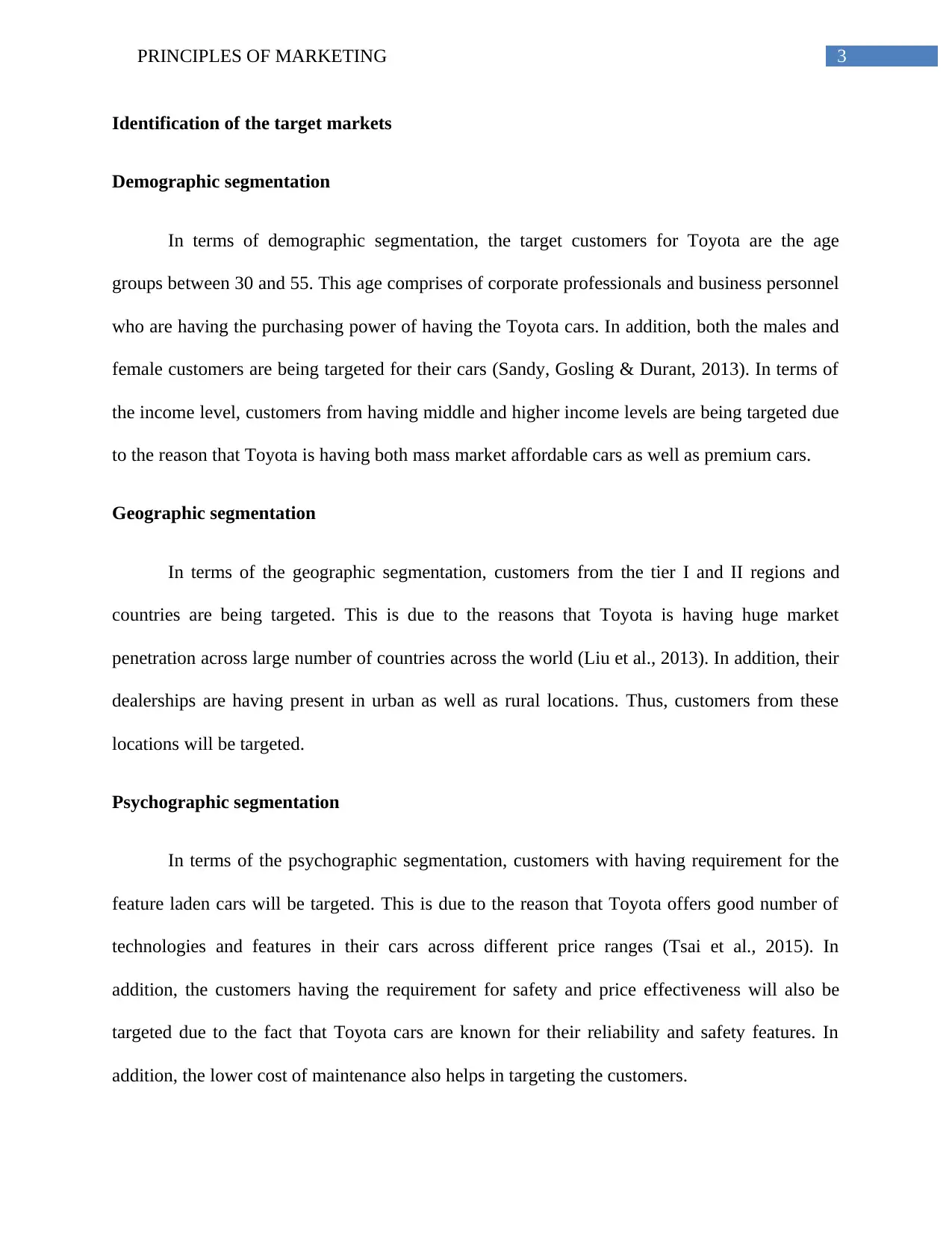
3PRINCIPLES OF MARKETING
Identification of the target markets
Demographic segmentation
In terms of demographic segmentation, the target customers for Toyota are the age
groups between 30 and 55. This age comprises of corporate professionals and business personnel
who are having the purchasing power of having the Toyota cars. In addition, both the males and
female customers are being targeted for their cars (Sandy, Gosling & Durant, 2013). In terms of
the income level, customers from having middle and higher income levels are being targeted due
to the reason that Toyota is having both mass market affordable cars as well as premium cars.
Geographic segmentation
In terms of the geographic segmentation, customers from the tier I and II regions and
countries are being targeted. This is due to the reasons that Toyota is having huge market
penetration across large number of countries across the world (Liu et al., 2013). In addition, their
dealerships are having present in urban as well as rural locations. Thus, customers from these
locations will be targeted.
Psychographic segmentation
In terms of the psychographic segmentation, customers with having requirement for the
feature laden cars will be targeted. This is due to the reason that Toyota offers good number of
technologies and features in their cars across different price ranges (Tsai et al., 2015). In
addition, the customers having the requirement for safety and price effectiveness will also be
targeted due to the fact that Toyota cars are known for their reliability and safety features. In
addition, the lower cost of maintenance also helps in targeting the customers.
Identification of the target markets
Demographic segmentation
In terms of demographic segmentation, the target customers for Toyota are the age
groups between 30 and 55. This age comprises of corporate professionals and business personnel
who are having the purchasing power of having the Toyota cars. In addition, both the males and
female customers are being targeted for their cars (Sandy, Gosling & Durant, 2013). In terms of
the income level, customers from having middle and higher income levels are being targeted due
to the reason that Toyota is having both mass market affordable cars as well as premium cars.
Geographic segmentation
In terms of the geographic segmentation, customers from the tier I and II regions and
countries are being targeted. This is due to the reasons that Toyota is having huge market
penetration across large number of countries across the world (Liu et al., 2013). In addition, their
dealerships are having present in urban as well as rural locations. Thus, customers from these
locations will be targeted.
Psychographic segmentation
In terms of the psychographic segmentation, customers with having requirement for the
feature laden cars will be targeted. This is due to the reason that Toyota offers good number of
technologies and features in their cars across different price ranges (Tsai et al., 2015). In
addition, the customers having the requirement for safety and price effectiveness will also be
targeted due to the fact that Toyota cars are known for their reliability and safety features. In
addition, the lower cost of maintenance also helps in targeting the customers.
Secure Best Marks with AI Grader
Need help grading? Try our AI Grader for instant feedback on your assignments.
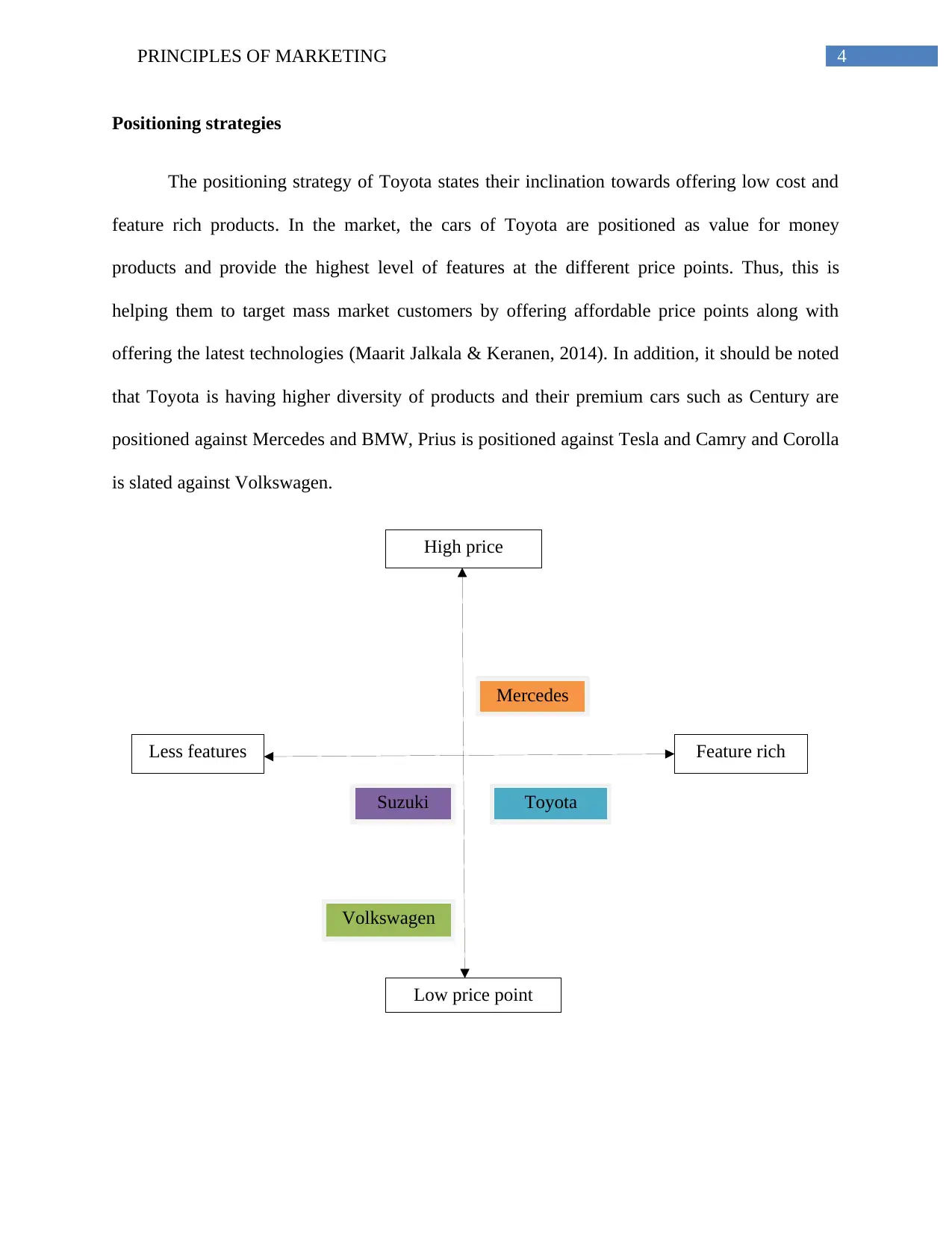
4PRINCIPLES OF MARKETING
High price
Low price point
Feature richLess features
Toyota
Mercedes
Volkswagen
Suzuki
Positioning strategies
The positioning strategy of Toyota states their inclination towards offering low cost and
feature rich products. In the market, the cars of Toyota are positioned as value for money
products and provide the highest level of features at the different price points. Thus, this is
helping them to target mass market customers by offering affordable price points along with
offering the latest technologies (Maarit Jalkala & Keranen, 2014). In addition, it should be noted
that Toyota is having higher diversity of products and their premium cars such as Century are
positioned against Mercedes and BMW, Prius is positioned against Tesla and Camry and Corolla
is slated against Volkswagen.
High price
Low price point
Feature richLess features
Toyota
Mercedes
Volkswagen
Suzuki
Positioning strategies
The positioning strategy of Toyota states their inclination towards offering low cost and
feature rich products. In the market, the cars of Toyota are positioned as value for money
products and provide the highest level of features at the different price points. Thus, this is
helping them to target mass market customers by offering affordable price points along with
offering the latest technologies (Maarit Jalkala & Keranen, 2014). In addition, it should be noted
that Toyota is having higher diversity of products and their premium cars such as Century are
positioned against Mercedes and BMW, Prius is positioned against Tesla and Camry and Corolla
is slated against Volkswagen.
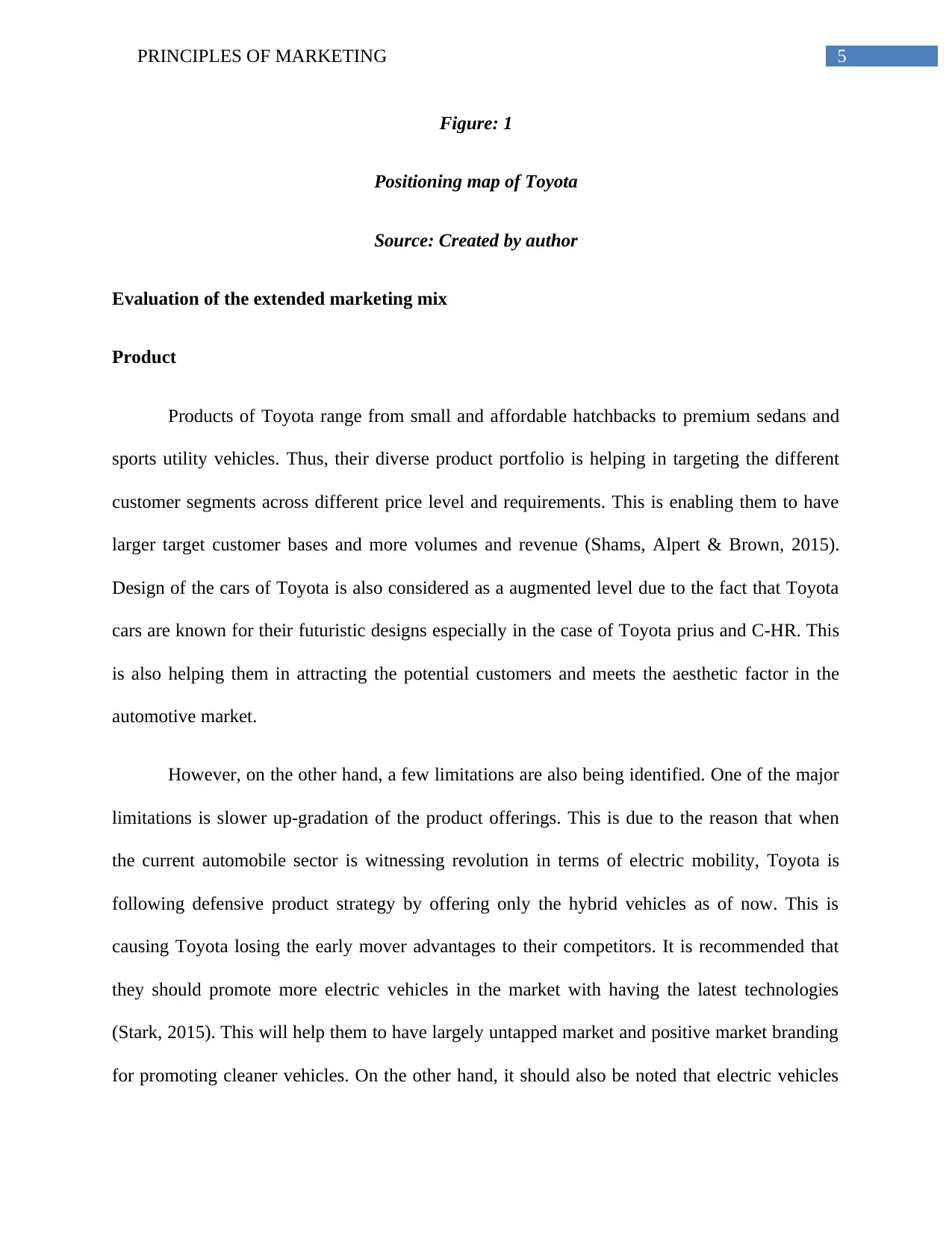
5PRINCIPLES OF MARKETING
Figure: 1
Positioning map of Toyota
Source: Created by author
Evaluation of the extended marketing mix
Product
Products of Toyota range from small and affordable hatchbacks to premium sedans and
sports utility vehicles. Thus, their diverse product portfolio is helping in targeting the different
customer segments across different price level and requirements. This is enabling them to have
larger target customer bases and more volumes and revenue (Shams, Alpert & Brown, 2015).
Design of the cars of Toyota is also considered as a augmented level due to the fact that Toyota
cars are known for their futuristic designs especially in the case of Toyota prius and C-HR. This
is also helping them in attracting the potential customers and meets the aesthetic factor in the
automotive market.
However, on the other hand, a few limitations are also being identified. One of the major
limitations is slower up-gradation of the product offerings. This is due to the reason that when
the current automobile sector is witnessing revolution in terms of electric mobility, Toyota is
following defensive product strategy by offering only the hybrid vehicles as of now. This is
causing Toyota losing the early mover advantages to their competitors. It is recommended that
they should promote more electric vehicles in the market with having the latest technologies
(Stark, 2015). This will help them to have largely untapped market and positive market branding
for promoting cleaner vehicles. On the other hand, it should also be noted that electric vehicles
Figure: 1
Positioning map of Toyota
Source: Created by author
Evaluation of the extended marketing mix
Product
Products of Toyota range from small and affordable hatchbacks to premium sedans and
sports utility vehicles. Thus, their diverse product portfolio is helping in targeting the different
customer segments across different price level and requirements. This is enabling them to have
larger target customer bases and more volumes and revenue (Shams, Alpert & Brown, 2015).
Design of the cars of Toyota is also considered as a augmented level due to the fact that Toyota
cars are known for their futuristic designs especially in the case of Toyota prius and C-HR. This
is also helping them in attracting the potential customers and meets the aesthetic factor in the
automotive market.
However, on the other hand, a few limitations are also being identified. One of the major
limitations is slower up-gradation of the product offerings. This is due to the reason that when
the current automobile sector is witnessing revolution in terms of electric mobility, Toyota is
following defensive product strategy by offering only the hybrid vehicles as of now. This is
causing Toyota losing the early mover advantages to their competitors. It is recommended that
they should promote more electric vehicles in the market with having the latest technologies
(Stark, 2015). This will help them to have largely untapped market and positive market branding
for promoting cleaner vehicles. On the other hand, it should also be noted that electric vehicles
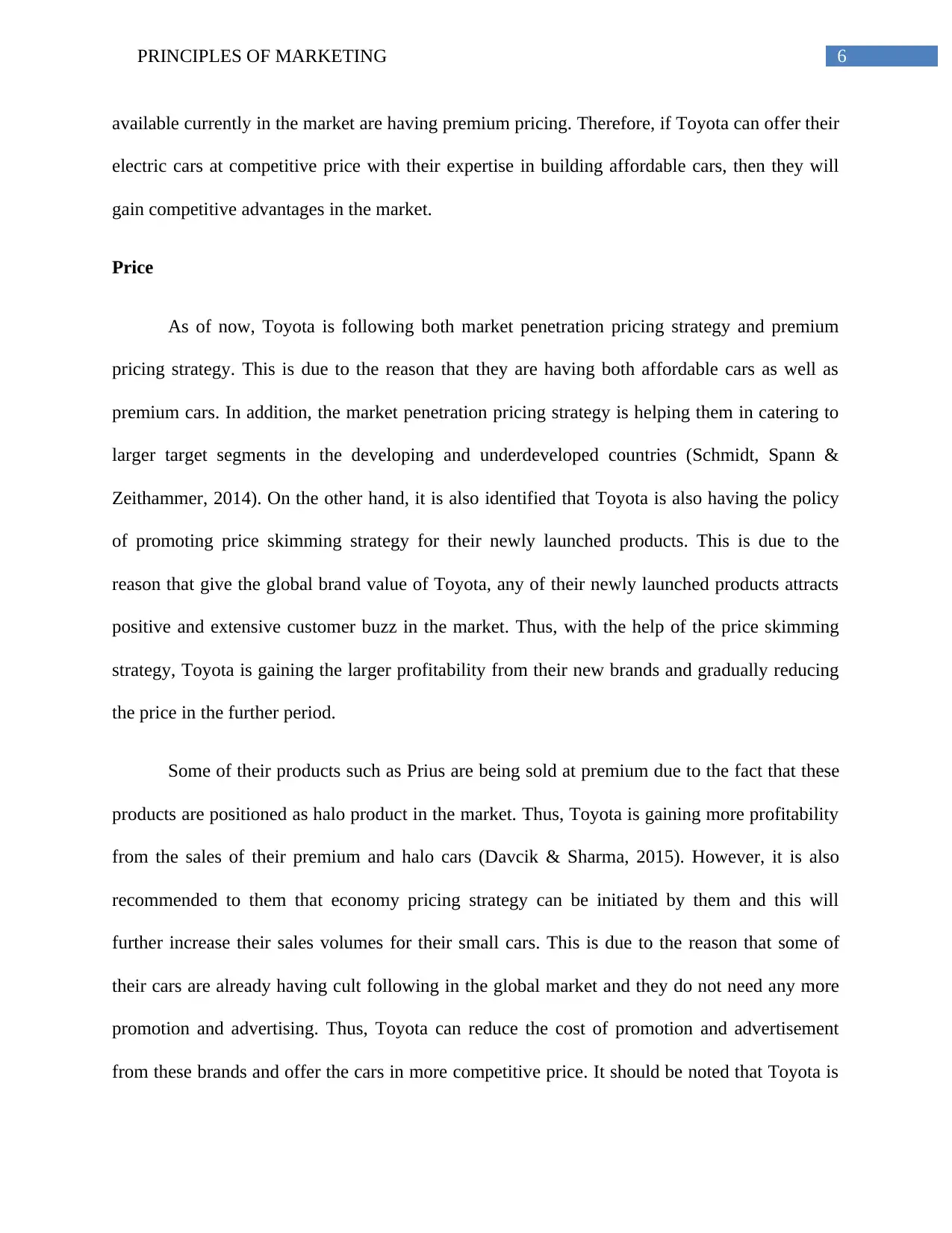
6PRINCIPLES OF MARKETING
available currently in the market are having premium pricing. Therefore, if Toyota can offer their
electric cars at competitive price with their expertise in building affordable cars, then they will
gain competitive advantages in the market.
Price
As of now, Toyota is following both market penetration pricing strategy and premium
pricing strategy. This is due to the reason that they are having both affordable cars as well as
premium cars. In addition, the market penetration pricing strategy is helping them in catering to
larger target segments in the developing and underdeveloped countries (Schmidt, Spann &
Zeithammer, 2014). On the other hand, it is also identified that Toyota is also having the policy
of promoting price skimming strategy for their newly launched products. This is due to the
reason that give the global brand value of Toyota, any of their newly launched products attracts
positive and extensive customer buzz in the market. Thus, with the help of the price skimming
strategy, Toyota is gaining the larger profitability from their new brands and gradually reducing
the price in the further period.
Some of their products such as Prius are being sold at premium due to the fact that these
products are positioned as halo product in the market. Thus, Toyota is gaining more profitability
from the sales of their premium and halo cars (Davcik & Sharma, 2015). However, it is also
recommended to them that economy pricing strategy can be initiated by them and this will
further increase their sales volumes for their small cars. This is due to the reason that some of
their cars are already having cult following in the global market and they do not need any more
promotion and advertising. Thus, Toyota can reduce the cost of promotion and advertisement
from these brands and offer the cars in more competitive price. It should be noted that Toyota is
available currently in the market are having premium pricing. Therefore, if Toyota can offer their
electric cars at competitive price with their expertise in building affordable cars, then they will
gain competitive advantages in the market.
Price
As of now, Toyota is following both market penetration pricing strategy and premium
pricing strategy. This is due to the reason that they are having both affordable cars as well as
premium cars. In addition, the market penetration pricing strategy is helping them in catering to
larger target segments in the developing and underdeveloped countries (Schmidt, Spann &
Zeithammer, 2014). On the other hand, it is also identified that Toyota is also having the policy
of promoting price skimming strategy for their newly launched products. This is due to the
reason that give the global brand value of Toyota, any of their newly launched products attracts
positive and extensive customer buzz in the market. Thus, with the help of the price skimming
strategy, Toyota is gaining the larger profitability from their new brands and gradually reducing
the price in the further period.
Some of their products such as Prius are being sold at premium due to the fact that these
products are positioned as halo product in the market. Thus, Toyota is gaining more profitability
from the sales of their premium and halo cars (Davcik & Sharma, 2015). However, it is also
recommended to them that economy pricing strategy can be initiated by them and this will
further increase their sales volumes for their small cars. This is due to the reason that some of
their cars are already having cult following in the global market and they do not need any more
promotion and advertising. Thus, Toyota can reduce the cost of promotion and advertisement
from these brands and offer the cars in more competitive price. It should be noted that Toyota is
Paraphrase This Document
Need a fresh take? Get an instant paraphrase of this document with our AI Paraphraser
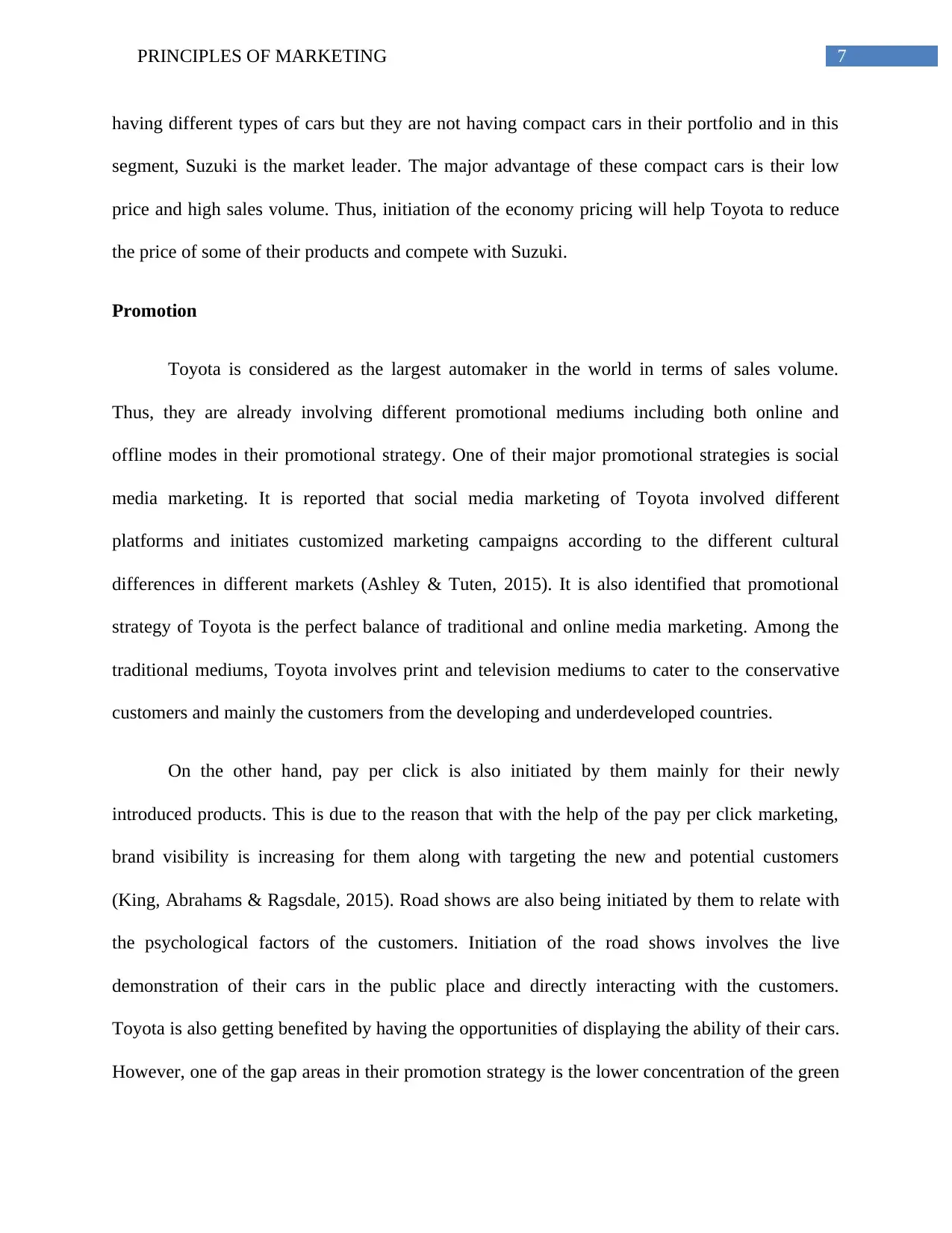
7PRINCIPLES OF MARKETING
having different types of cars but they are not having compact cars in their portfolio and in this
segment, Suzuki is the market leader. The major advantage of these compact cars is their low
price and high sales volume. Thus, initiation of the economy pricing will help Toyota to reduce
the price of some of their products and compete with Suzuki.
Promotion
Toyota is considered as the largest automaker in the world in terms of sales volume.
Thus, they are already involving different promotional mediums including both online and
offline modes in their promotional strategy. One of their major promotional strategies is social
media marketing. It is reported that social media marketing of Toyota involved different
platforms and initiates customized marketing campaigns according to the different cultural
differences in different markets (Ashley & Tuten, 2015). It is also identified that promotional
strategy of Toyota is the perfect balance of traditional and online media marketing. Among the
traditional mediums, Toyota involves print and television mediums to cater to the conservative
customers and mainly the customers from the developing and underdeveloped countries.
On the other hand, pay per click is also initiated by them mainly for their newly
introduced products. This is due to the reason that with the help of the pay per click marketing,
brand visibility is increasing for them along with targeting the new and potential customers
(King, Abrahams & Ragsdale, 2015). Road shows are also being initiated by them to relate with
the psychological factors of the customers. Initiation of the road shows involves the live
demonstration of their cars in the public place and directly interacting with the customers.
Toyota is also getting benefited by having the opportunities of displaying the ability of their cars.
However, one of the gap areas in their promotion strategy is the lower concentration of the green
having different types of cars but they are not having compact cars in their portfolio and in this
segment, Suzuki is the market leader. The major advantage of these compact cars is their low
price and high sales volume. Thus, initiation of the economy pricing will help Toyota to reduce
the price of some of their products and compete with Suzuki.
Promotion
Toyota is considered as the largest automaker in the world in terms of sales volume.
Thus, they are already involving different promotional mediums including both online and
offline modes in their promotional strategy. One of their major promotional strategies is social
media marketing. It is reported that social media marketing of Toyota involved different
platforms and initiates customized marketing campaigns according to the different cultural
differences in different markets (Ashley & Tuten, 2015). It is also identified that promotional
strategy of Toyota is the perfect balance of traditional and online media marketing. Among the
traditional mediums, Toyota involves print and television mediums to cater to the conservative
customers and mainly the customers from the developing and underdeveloped countries.
On the other hand, pay per click is also initiated by them mainly for their newly
introduced products. This is due to the reason that with the help of the pay per click marketing,
brand visibility is increasing for them along with targeting the new and potential customers
(King, Abrahams & Ragsdale, 2015). Road shows are also being initiated by them to relate with
the psychological factors of the customers. Initiation of the road shows involves the live
demonstration of their cars in the public place and directly interacting with the customers.
Toyota is also getting benefited by having the opportunities of displaying the ability of their cars.
However, one of the gap areas in their promotion strategy is the lower concentration of the green
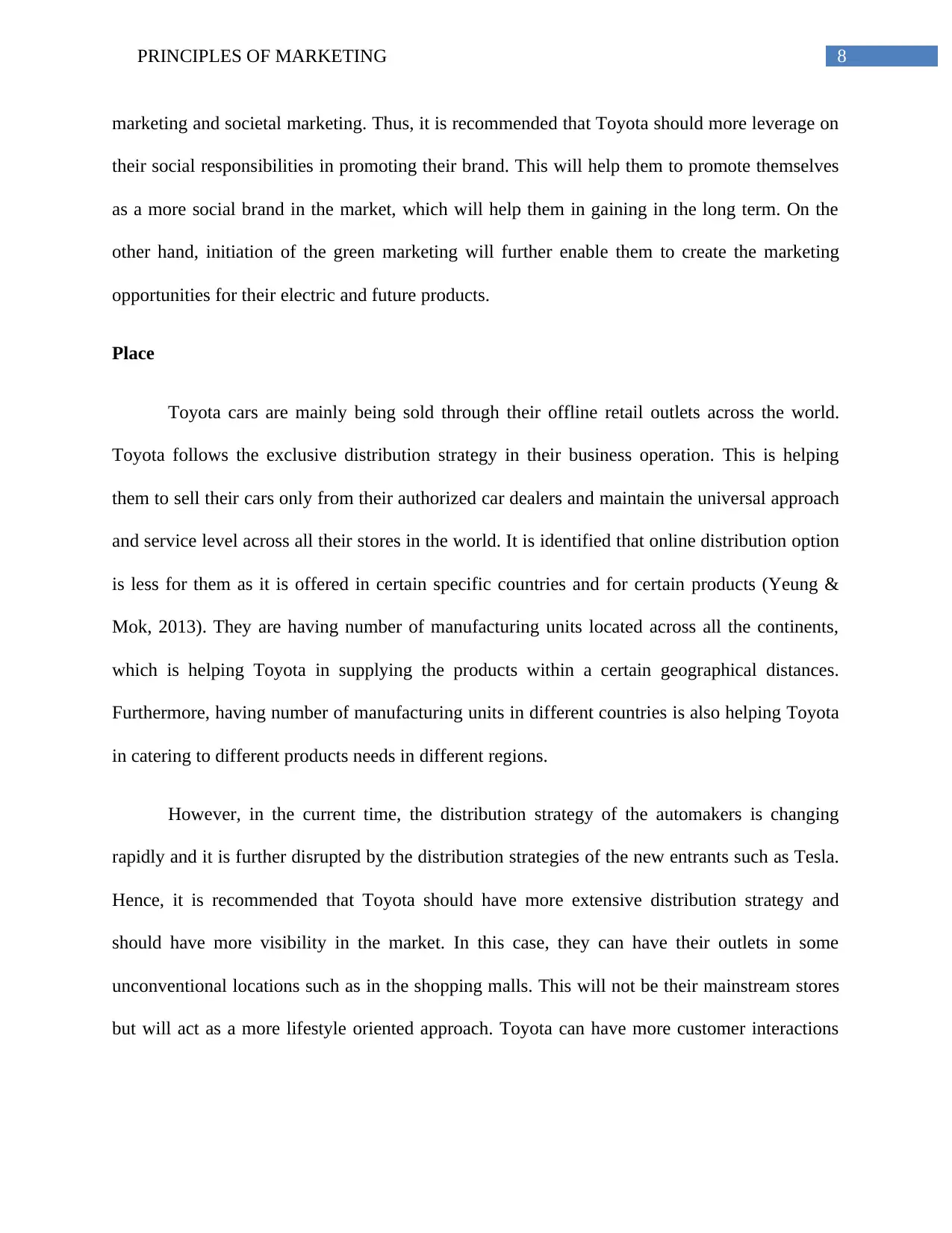
8PRINCIPLES OF MARKETING
marketing and societal marketing. Thus, it is recommended that Toyota should more leverage on
their social responsibilities in promoting their brand. This will help them to promote themselves
as a more social brand in the market, which will help them in gaining in the long term. On the
other hand, initiation of the green marketing will further enable them to create the marketing
opportunities for their electric and future products.
Place
Toyota cars are mainly being sold through their offline retail outlets across the world.
Toyota follows the exclusive distribution strategy in their business operation. This is helping
them to sell their cars only from their authorized car dealers and maintain the universal approach
and service level across all their stores in the world. It is identified that online distribution option
is less for them as it is offered in certain specific countries and for certain products (Yeung &
Mok, 2013). They are having number of manufacturing units located across all the continents,
which is helping Toyota in supplying the products within a certain geographical distances.
Furthermore, having number of manufacturing units in different countries is also helping Toyota
in catering to different products needs in different regions.
However, in the current time, the distribution strategy of the automakers is changing
rapidly and it is further disrupted by the distribution strategies of the new entrants such as Tesla.
Hence, it is recommended that Toyota should have more extensive distribution strategy and
should have more visibility in the market. In this case, they can have their outlets in some
unconventional locations such as in the shopping malls. This will not be their mainstream stores
but will act as a more lifestyle oriented approach. Toyota can have more customer interactions
marketing and societal marketing. Thus, it is recommended that Toyota should more leverage on
their social responsibilities in promoting their brand. This will help them to promote themselves
as a more social brand in the market, which will help them in gaining in the long term. On the
other hand, initiation of the green marketing will further enable them to create the marketing
opportunities for their electric and future products.
Place
Toyota cars are mainly being sold through their offline retail outlets across the world.
Toyota follows the exclusive distribution strategy in their business operation. This is helping
them to sell their cars only from their authorized car dealers and maintain the universal approach
and service level across all their stores in the world. It is identified that online distribution option
is less for them as it is offered in certain specific countries and for certain products (Yeung &
Mok, 2013). They are having number of manufacturing units located across all the continents,
which is helping Toyota in supplying the products within a certain geographical distances.
Furthermore, having number of manufacturing units in different countries is also helping Toyota
in catering to different products needs in different regions.
However, in the current time, the distribution strategy of the automakers is changing
rapidly and it is further disrupted by the distribution strategies of the new entrants such as Tesla.
Hence, it is recommended that Toyota should have more extensive distribution strategy and
should have more visibility in the market. In this case, they can have their outlets in some
unconventional locations such as in the shopping malls. This will not be their mainstream stores
but will act as a more lifestyle oriented approach. Toyota can have more customer interactions
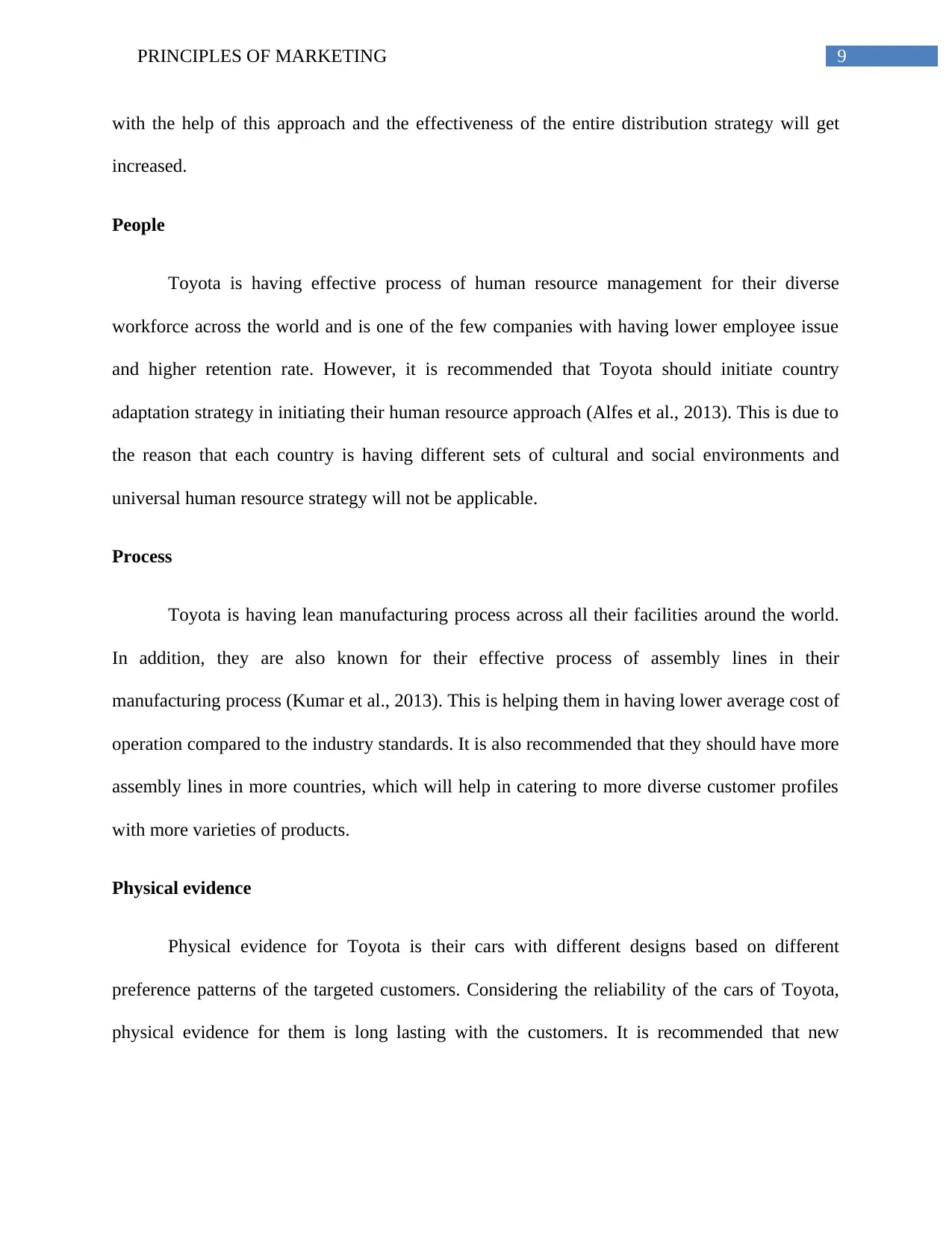
9PRINCIPLES OF MARKETING
with the help of this approach and the effectiveness of the entire distribution strategy will get
increased.
People
Toyota is having effective process of human resource management for their diverse
workforce across the world and is one of the few companies with having lower employee issue
and higher retention rate. However, it is recommended that Toyota should initiate country
adaptation strategy in initiating their human resource approach (Alfes et al., 2013). This is due to
the reason that each country is having different sets of cultural and social environments and
universal human resource strategy will not be applicable.
Process
Toyota is having lean manufacturing process across all their facilities around the world.
In addition, they are also known for their effective process of assembly lines in their
manufacturing process (Kumar et al., 2013). This is helping them in having lower average cost of
operation compared to the industry standards. It is also recommended that they should have more
assembly lines in more countries, which will help in catering to more diverse customer profiles
with more varieties of products.
Physical evidence
Physical evidence for Toyota is their cars with different designs based on different
preference patterns of the targeted customers. Considering the reliability of the cars of Toyota,
physical evidence for them is long lasting with the customers. It is recommended that new
with the help of this approach and the effectiveness of the entire distribution strategy will get
increased.
People
Toyota is having effective process of human resource management for their diverse
workforce across the world and is one of the few companies with having lower employee issue
and higher retention rate. However, it is recommended that Toyota should initiate country
adaptation strategy in initiating their human resource approach (Alfes et al., 2013). This is due to
the reason that each country is having different sets of cultural and social environments and
universal human resource strategy will not be applicable.
Process
Toyota is having lean manufacturing process across all their facilities around the world.
In addition, they are also known for their effective process of assembly lines in their
manufacturing process (Kumar et al., 2013). This is helping them in having lower average cost of
operation compared to the industry standards. It is also recommended that they should have more
assembly lines in more countries, which will help in catering to more diverse customer profiles
with more varieties of products.
Physical evidence
Physical evidence for Toyota is their cars with different designs based on different
preference patterns of the targeted customers. Considering the reliability of the cars of Toyota,
physical evidence for them is long lasting with the customers. It is recommended that new
Secure Best Marks with AI Grader
Need help grading? Try our AI Grader for instant feedback on your assignments.
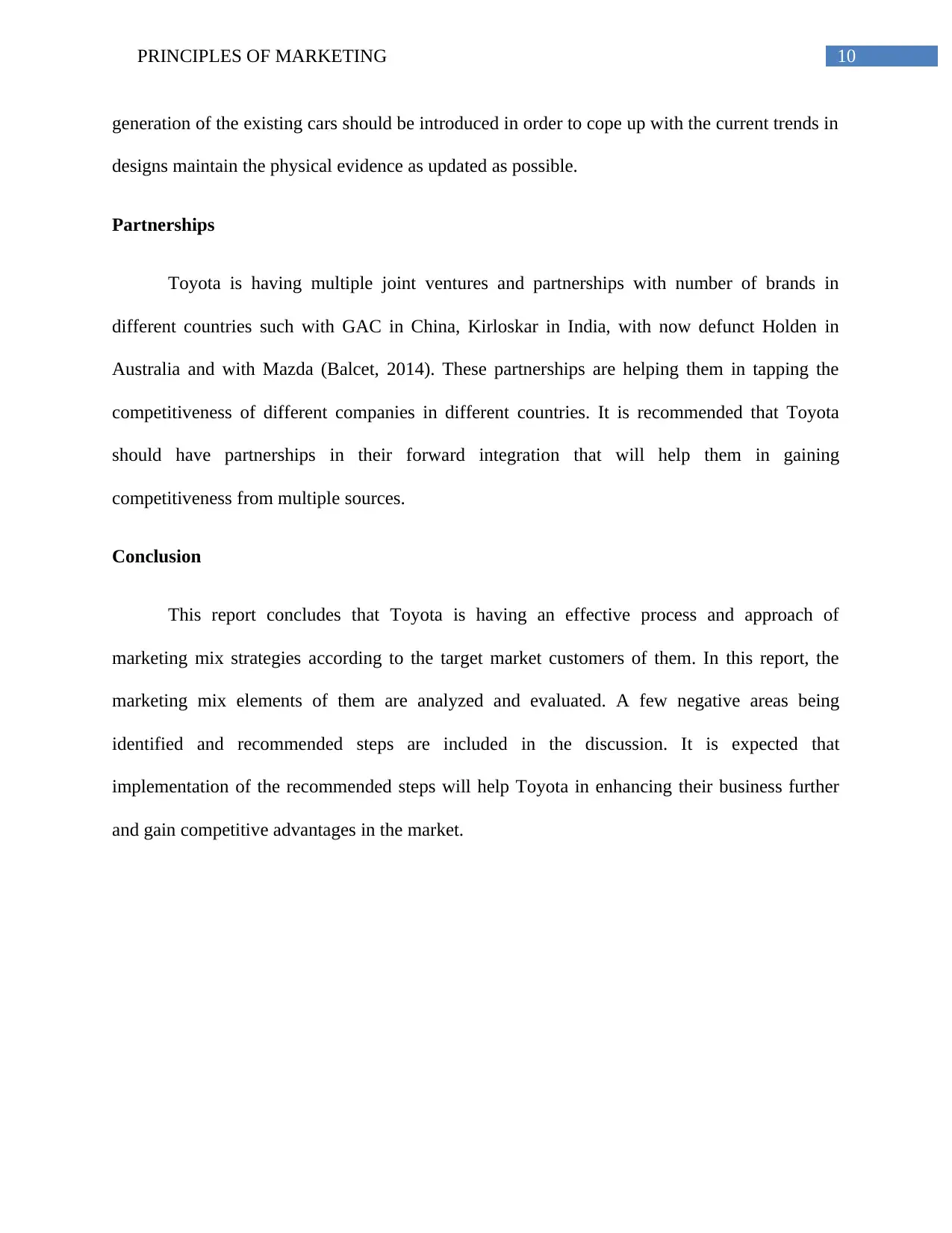
10PRINCIPLES OF MARKETING
generation of the existing cars should be introduced in order to cope up with the current trends in
designs maintain the physical evidence as updated as possible.
Partnerships
Toyota is having multiple joint ventures and partnerships with number of brands in
different countries such with GAC in China, Kirloskar in India, with now defunct Holden in
Australia and with Mazda (Balcet, 2014). These partnerships are helping them in tapping the
competitiveness of different companies in different countries. It is recommended that Toyota
should have partnerships in their forward integration that will help them in gaining
competitiveness from multiple sources.
Conclusion
This report concludes that Toyota is having an effective process and approach of
marketing mix strategies according to the target market customers of them. In this report, the
marketing mix elements of them are analyzed and evaluated. A few negative areas being
identified and recommended steps are included in the discussion. It is expected that
implementation of the recommended steps will help Toyota in enhancing their business further
and gain competitive advantages in the market.
generation of the existing cars should be introduced in order to cope up with the current trends in
designs maintain the physical evidence as updated as possible.
Partnerships
Toyota is having multiple joint ventures and partnerships with number of brands in
different countries such with GAC in China, Kirloskar in India, with now defunct Holden in
Australia and with Mazda (Balcet, 2014). These partnerships are helping them in tapping the
competitiveness of different companies in different countries. It is recommended that Toyota
should have partnerships in their forward integration that will help them in gaining
competitiveness from multiple sources.
Conclusion
This report concludes that Toyota is having an effective process and approach of
marketing mix strategies according to the target market customers of them. In this report, the
marketing mix elements of them are analyzed and evaluated. A few negative areas being
identified and recommended steps are included in the discussion. It is expected that
implementation of the recommended steps will help Toyota in enhancing their business further
and gain competitive advantages in the market.
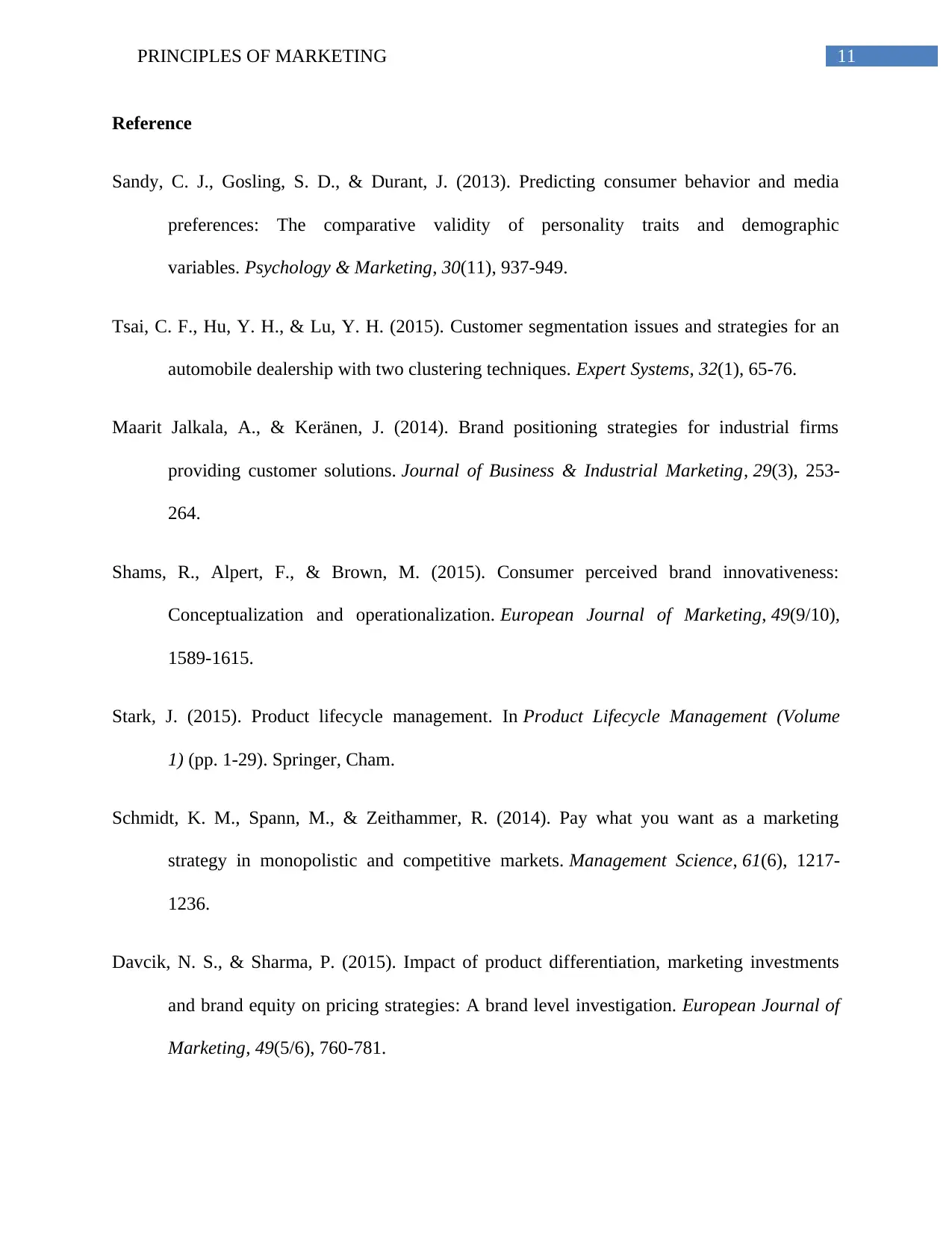
11PRINCIPLES OF MARKETING
Reference
Sandy, C. J., Gosling, S. D., & Durant, J. (2013). Predicting consumer behavior and media
preferences: The comparative validity of personality traits and demographic
variables. Psychology & Marketing, 30(11), 937-949.
Tsai, C. F., Hu, Y. H., & Lu, Y. H. (2015). Customer segmentation issues and strategies for an
automobile dealership with two clustering techniques. Expert Systems, 32(1), 65-76.
Maarit Jalkala, A., & Keränen, J. (2014). Brand positioning strategies for industrial firms
providing customer solutions. Journal of Business & Industrial Marketing, 29(3), 253-
264.
Shams, R., Alpert, F., & Brown, M. (2015). Consumer perceived brand innovativeness:
Conceptualization and operationalization. European Journal of Marketing, 49(9/10),
1589-1615.
Stark, J. (2015). Product lifecycle management. In Product Lifecycle Management (Volume
1) (pp. 1-29). Springer, Cham.
Schmidt, K. M., Spann, M., & Zeithammer, R. (2014). Pay what you want as a marketing
strategy in monopolistic and competitive markets. Management Science, 61(6), 1217-
1236.
Davcik, N. S., & Sharma, P. (2015). Impact of product differentiation, marketing investments
and brand equity on pricing strategies: A brand level investigation. European Journal of
Marketing, 49(5/6), 760-781.
Reference
Sandy, C. J., Gosling, S. D., & Durant, J. (2013). Predicting consumer behavior and media
preferences: The comparative validity of personality traits and demographic
variables. Psychology & Marketing, 30(11), 937-949.
Tsai, C. F., Hu, Y. H., & Lu, Y. H. (2015). Customer segmentation issues and strategies for an
automobile dealership with two clustering techniques. Expert Systems, 32(1), 65-76.
Maarit Jalkala, A., & Keränen, J. (2014). Brand positioning strategies for industrial firms
providing customer solutions. Journal of Business & Industrial Marketing, 29(3), 253-
264.
Shams, R., Alpert, F., & Brown, M. (2015). Consumer perceived brand innovativeness:
Conceptualization and operationalization. European Journal of Marketing, 49(9/10),
1589-1615.
Stark, J. (2015). Product lifecycle management. In Product Lifecycle Management (Volume
1) (pp. 1-29). Springer, Cham.
Schmidt, K. M., Spann, M., & Zeithammer, R. (2014). Pay what you want as a marketing
strategy in monopolistic and competitive markets. Management Science, 61(6), 1217-
1236.
Davcik, N. S., & Sharma, P. (2015). Impact of product differentiation, marketing investments
and brand equity on pricing strategies: A brand level investigation. European Journal of
Marketing, 49(5/6), 760-781.
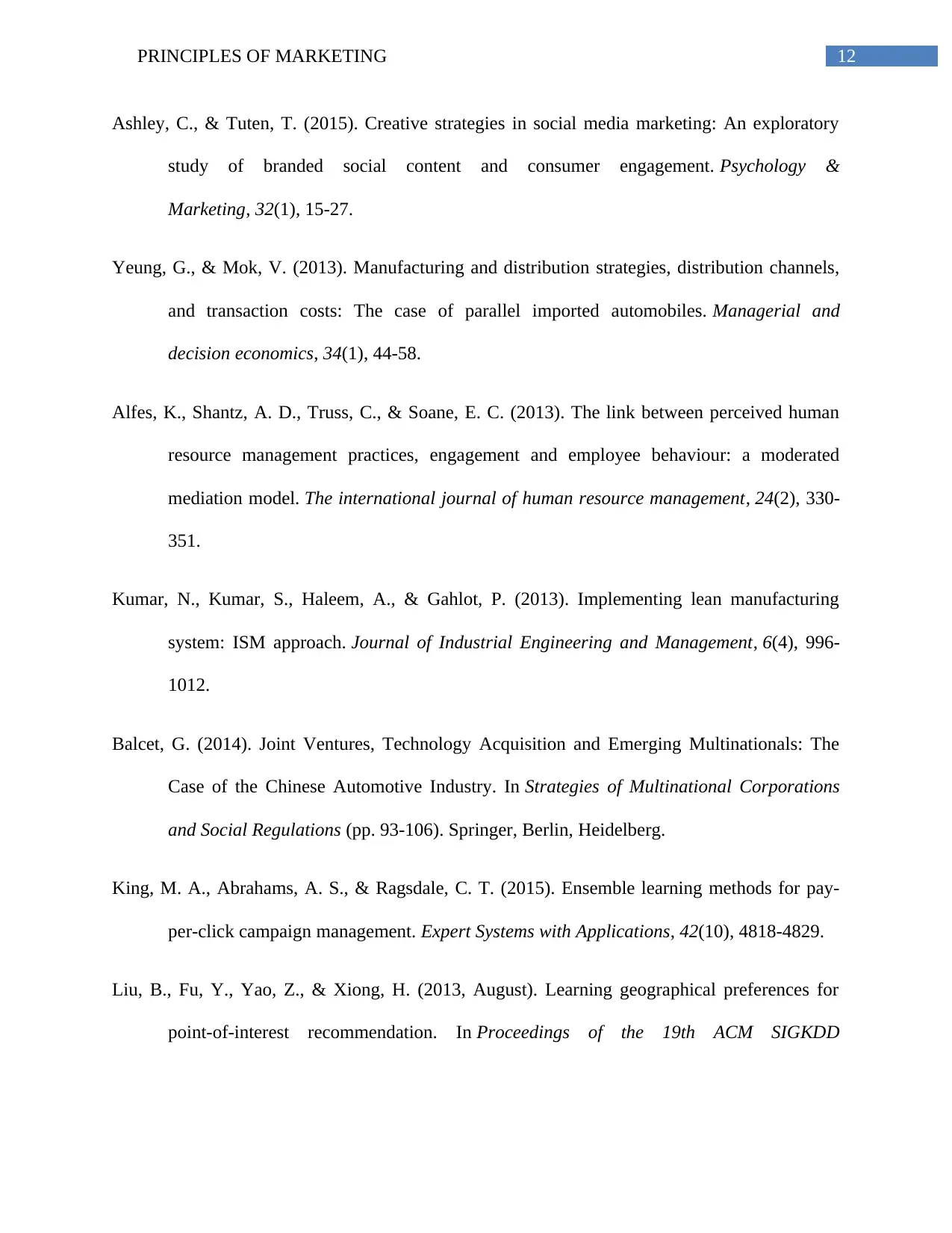
12PRINCIPLES OF MARKETING
Ashley, C., & Tuten, T. (2015). Creative strategies in social media marketing: An exploratory
study of branded social content and consumer engagement. Psychology &
Marketing, 32(1), 15-27.
Yeung, G., & Mok, V. (2013). Manufacturing and distribution strategies, distribution channels,
and transaction costs: The case of parallel imported automobiles. Managerial and
decision economics, 34(1), 44-58.
Alfes, K., Shantz, A. D., Truss, C., & Soane, E. C. (2013). The link between perceived human
resource management practices, engagement and employee behaviour: a moderated
mediation model. The international journal of human resource management, 24(2), 330-
351.
Kumar, N., Kumar, S., Haleem, A., & Gahlot, P. (2013). Implementing lean manufacturing
system: ISM approach. Journal of Industrial Engineering and Management, 6(4), 996-
1012.
Balcet, G. (2014). Joint Ventures, Technology Acquisition and Emerging Multinationals: The
Case of the Chinese Automotive Industry. In Strategies of Multinational Corporations
and Social Regulations (pp. 93-106). Springer, Berlin, Heidelberg.
King, M. A., Abrahams, A. S., & Ragsdale, C. T. (2015). Ensemble learning methods for pay-
per-click campaign management. Expert Systems with Applications, 42(10), 4818-4829.
Liu, B., Fu, Y., Yao, Z., & Xiong, H. (2013, August). Learning geographical preferences for
point-of-interest recommendation. In Proceedings of the 19th ACM SIGKDD
Ashley, C., & Tuten, T. (2015). Creative strategies in social media marketing: An exploratory
study of branded social content and consumer engagement. Psychology &
Marketing, 32(1), 15-27.
Yeung, G., & Mok, V. (2013). Manufacturing and distribution strategies, distribution channels,
and transaction costs: The case of parallel imported automobiles. Managerial and
decision economics, 34(1), 44-58.
Alfes, K., Shantz, A. D., Truss, C., & Soane, E. C. (2013). The link between perceived human
resource management practices, engagement and employee behaviour: a moderated
mediation model. The international journal of human resource management, 24(2), 330-
351.
Kumar, N., Kumar, S., Haleem, A., & Gahlot, P. (2013). Implementing lean manufacturing
system: ISM approach. Journal of Industrial Engineering and Management, 6(4), 996-
1012.
Balcet, G. (2014). Joint Ventures, Technology Acquisition and Emerging Multinationals: The
Case of the Chinese Automotive Industry. In Strategies of Multinational Corporations
and Social Regulations (pp. 93-106). Springer, Berlin, Heidelberg.
King, M. A., Abrahams, A. S., & Ragsdale, C. T. (2015). Ensemble learning methods for pay-
per-click campaign management. Expert Systems with Applications, 42(10), 4818-4829.
Liu, B., Fu, Y., Yao, Z., & Xiong, H. (2013, August). Learning geographical preferences for
point-of-interest recommendation. In Proceedings of the 19th ACM SIGKDD
Paraphrase This Document
Need a fresh take? Get an instant paraphrase of this document with our AI Paraphraser

13PRINCIPLES OF MARKETING
international conference on Knowledge discovery and data mining (pp. 1043-1051).
ACM.
international conference on Knowledge discovery and data mining (pp. 1043-1051).
ACM.
1 out of 14
Related Documents
Your All-in-One AI-Powered Toolkit for Academic Success.
+13062052269
info@desklib.com
Available 24*7 on WhatsApp / Email
![[object Object]](/_next/static/media/star-bottom.7253800d.svg)
Unlock your academic potential
© 2024 | Zucol Services PVT LTD | All rights reserved.




